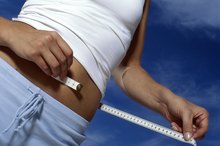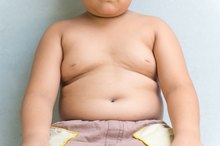How to Lose Belly Fat Fast for Kids
Belly fat in kids is just as serious of a health concern as it is for adults 1. According to research presented in a 2014 issue of the journal Pediatrics, from the years 2011 to 2012, almost 33 percent of children ages 6 to 18 years qualified as abdominally obese, according to their waist-to-height ratio. In adults, belly fat can sometimes be blamed on aging and changing hormones, but this isn't what's happening in kids. To lose belly fat, children need dietary revisions, commitment to healthy exercise and improved lifestyle habits.
Losing Belly Fat Basics
Children lose belly fat in much the same way adults do: by revising their dietary habits and moving more. To lose 1 pound of fat, you need to create a 3,500-calorie deficit. Belly fat is some of the first fat you lose when you make healthy changes because it's metabolically active. Serious dieting is discouraged in kids as it can leave them nutritionally deficient and hungry, not to mention set up an unhealthy relationship with food. Making changes to a child's dietary choices and loading their plates with healthier foods are ways to trim calories without losing nutrition for a growing body and brain. Exercise is another critical strategy in losing belly fat. Only one in three children are physically active daily, reports the President's Council on Fitness, Sports & Nutrition 3.
The number one step in helping kids lose belly fat, though, is having them quit their soda habit. A 2013 review published in Hippokratia confirmed that among children ages 7 to 15, sugar-sweetened beverages correlate with obesity 4. This confirmed previous research published in a 2007 American Journal of Public Health showing that soda and other sugary beverages correlate with increased body weight and risk of medical problems. Children who drank soft drinks also were less likely to get adequate calcium and nutrients from milk. Switching to water, sparkling water, plain iced tea or even milk helps kids reduce calorie intake immediately and lose belly fat fast.
- Children lose belly fat in much the same way adults do: by revising their dietary habits and moving more.
- This confirmed previous research published in a 2007 American Journal of Public Health showing that soda and other sugary beverages correlate with increased body weight and risk of medical problems.
Simple Dietary Changes for Kids
10 Ways for Teens to Quickly Lose Belly Weight
Learn More
The typical American diet contains far more sugar, saturated fats and refined grains than recommended for good health. Americans also eat fewer vegetables, fruits and whole grains than recommended. Reverse this trend in your own household to help a child lose belly fat. Dismiss the low-nutrition, high-calorie snacks, such as chips, cookies and candy. Fill the pantry with high-nutrient, kid-friendly options such as:
- fresh fruit
- low-fat yogurt
- whole-grain crackers
- string cheese
- nut butter
- The typical American diet contains far more sugar, saturated fats and refined grains than recommended for good health.
- Dismiss the low-nutrition, high-calorie snacks, such as chips, cookies and candy.
Kids Need Exercise to Lose Belly Fat
Children and adolescents need at least one hour of activity per day 8. This doesn't mean they have to run on a treadmill or exhaust themselves in P.E. ; instead, find opportunities for exercise that are fun. Maybe your child would like to join a dance class, martial arts or a local soccer team. Alternatively, have the kids walk the dog, ride their bikes or take a stroll with the family after dinner. Take them to a playground so they can incorporate muscle- and bone-strengthening exercises in their weekly activity, too.
Limit screen time, whether it's video games, television or smartphone use. A study published in the Journal of Physical Activity and Health in 2014 found that more than three hours per day of screen time resulted in a greater risk of kids being overweight or obese 7. The more time kids spend with media, the less time they have to be active.
- Children and adolescents need at least one hour of activity per day 8.
- Take them to a playground so they can incorporate muscle- and bone-strengthening exercises in their weekly activity, too.
Adequate Sleep and Reduced Stress
Diet & Exercises for a 7-Year-Old
Learn More
Kids need adequate sleep to stave off belly fat gain and grow properly. Preschoolers should get between 10 and 13 hours per day; school-age kids need nine to 11 hours; and teenagers should get eight to 10 hours, advises the National Sleep Foundation. A study published in Pediatrics in 2014 found an association between kids who chronically got too little sleep and higher levels of belly fat. To lose belly fat fast, go to bed earlier to ensure adequate sleep time.
Stress can also cause kids, just like adults, to pile on midsection pounds. School, peer pressure and family issues can cause kids to feel overwhelmed and pump out the hormone cortisol, which drives excess calories straight to the belly. A study published in a 2011 issue of Obesity showed this correlation between stress and belly fat in prepubescent girls. A child needs down time too; if your child is over-scheduled or subject to lots of stress in life, make time for fun and relaxation.
- Kids need adequate sleep to stave off belly fat gain and grow properly.
- A study published in Pediatrics in 2014 found an association between kids who chronically got too little sleep and higher levels of belly fat.
Related Articles
References
- Diabetes Health: Belly Fat Linked to Metabolic Diseases in Kids
- Pediatrics: Trends in Abdominal Obesity Among US Children and Adolescents
- President's Council on Fitness, Sports & Nutrition: Physical Activity
- Hippokratia: Is Beverage Intake Related to Overweight and Obesity in School Children?
- American Journal of Public Health: Effects of Soft Drink Consumption on Nutrition and Health: A Systematic Review and Meta-Analysis
- Harvard Health Publications: Taking Aim at Belly Fat
- Journal of Physical Activity and Health: Screen Time Increases Risk of Overweight and Obesity in Active and Inactive 9-Year-Old Irish Children: A Cross Sectional Analysis
- Centers for Disease Control and Prevention: How Much Physical Activity Do Children Need?
- Pediatrics: Chronic Sleep Curtailment and Adiposity
- Obesity: Stress and Abdominal Fat: Preliminary Evidence of Moderation by the Cortisol Awakening Response in Hispanic Peripubertal Girls
- What causes obesity & overweight? Eunice Kennedy Shriver National Institute of Child Health and Human Development. Reviewed December 1, 2016.
- Karvonen-Gutierrez C, Kim C. Association of Mid-Life Changes in Body Size, Body Composition and Obesity Status with the Menopausal Transition. Healthcare (Basel). 2016;4(3):42. Published 2016 Jul 13. doi:10.3390/healthcare4030042
- Stress, cortisol and abdominal fat. The American Institute of Stress.
- Assessing Your Weight. Centers for Disease Control and Prevention. Reviewed May 15, 2015.
- The Health Effects of Overweight and Obesity. Centers for Disease Control and Prevention. Reviewed May 15, 2015.
- Abdominal fat and what to do about it. Harvard Health Publishing. Updated June 25, 2019.
Resources
Writer Bio
Andrea Cespedes is a professionally trained chef who has focused studies in nutrition. With more than 20 years of experience in the fitness industry, she coaches cycling and running and teaches Pilates and yoga. She is an American Council on Exercise-certified personal trainer, RYT-200 and has degrees from Princeton and Columbia University.









